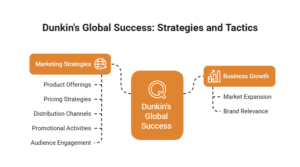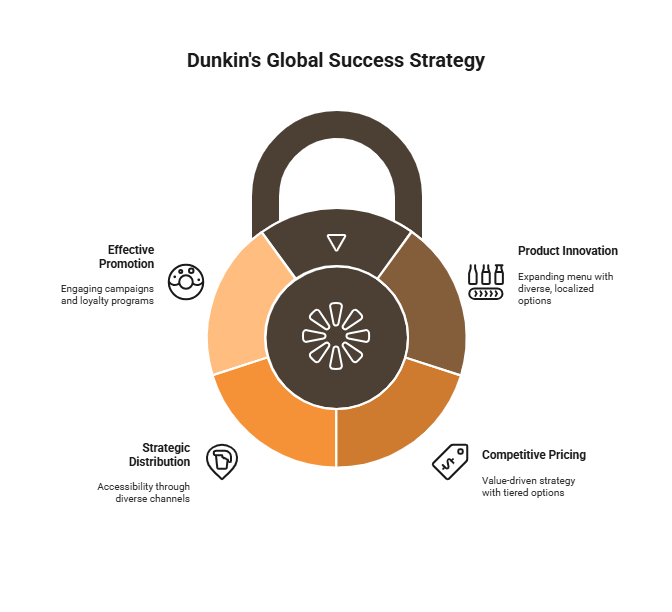How Dunkin’ Donuts Scaled: Product, Pricing & Promotion Tactics Uncovered

This case study explores the marketing strategies, business growth, and key tactics that have contributed to Dunkin’s global success as a leading quick-service restaurant (QSR). With over 21,000 stores in 60 countries, Dunkin’ has become synonymous with coffee and donuts, serving millions daily. The analysis provides valuable insights for businesses aiming to expand their reach and relevance in diverse markets by examining Dunkin’s product offerings, pricing strategies, distribution channels, promotional activities, and audience engagement.
Understanding Dunkin’s Marketing Strategy
1. Product
Dunkin’ Donuts offers much more than just donuts.
Offerings:
- Core Products: Donuts, coffee, bagels, breakfast sandwiches.
- Product Strategy: Focus on fast, affordable, and consistent breakfast/snack options.
- Innovation: Introduction of seasonal products (e.g., Pumpkin Spice Donuts), healthier options, and customization.
- Brand Positioning: “America Runs on Dunkin” – Fast, convenient, and energizing.
Key Takeaway:
Dunkin’ aligns its product development with consumer preferences: quick service, taste consistency, and portability.
2. Price
Dunkin’s pricing strategy is competitive and value-driven.
Strategy:
- Value Pricing: Positioned slightly lower than premium competitors like Starbucks.
- Bundles & Combos: Coffee + Donut combos at reduced prices.
- Tiered Options: Variety of price points catering to all budgets.
- Localized Pricing: Adjusted based on geography and store format (mall, standalone, etc.).
Key Takeaway:
The brand doesn’t just sell coffee—it sells affordable fuel for the day.
3. Place
Accessibility and convenience drive Dunkin’s distribution strategy.
Distribution Channels:
- Retail Outlets: Over 11,000 stores globally, especially strong in the U.S. Northeast.
- Drive-Thrus: Critical to serving time-sensitive morning consumers.
- Mobile App & Delivery: Orders, loyalty points, and delivery integrations.
- Non-Traditional Locations: Airports, gas stations, colleges.
Key Takeaway:
Dunkin’ wins on convenience. It’s wherever the customer needs it to be.
4. Promotion
Dunkin’s marketing strategy combines tradition with trendiness.
Strategy:
- Slogan & Messaging: “America Runs on Dunkin” creates an identity beyond the product.
- Digital Marketing: Strong presence on TikTok, Instagram, and Twitter with influencer campaigns (e.g., Charli D’Amelio collab).
- Loyalty Program: Dunkin’ Rewards to drive repeat business.
- Seasonal Campaigns: Limited-edition flavors, holiday promotions, and “Free Donut Day”.
Key Takeaway:
Promotion at Dunkin’ isn’t just selling—it’s about community, culture, and ritual
Deep Audience Insight
Dunkin’ excels at understanding its target audience: busy, value-conscious consumers seeking quick, affordable, and tasty food and beverages. The brand’s messaging emphasizes speed, convenience, and affordability, making it a go-to choice for morning routines and on-the-go snacking.
Key Growth Strategies
- Product Innovation & Diversification
- Beyond Donuts: Dunkin’ expanded its menu to include breakfast sandwiches, bagels, croissants, and plant-based options, appealing to a broader customer base.
- Beverage Focus: Recognizing the global coffee trend, Dunkin’ positioned itself as a coffee leader, introducing cold brews, iced lattes, and customizable drinks.
- Localization: The brand customizes its menu for regional tastes, such as Paneer Tikka Sandwiches in India and Matcha Green Tea Lattes in Singapore.
2. Digital Transformation
- Mobile App & Loyalty Programs: Dunkin’s DD Perks Rewards app allows customers to order ahead, customize orders, and earn rewards, driving repeat business and enhancing convenience.
- SEO & Local Search: Dunkin’ dominates local search results for “coffee near me,” boosting foot traffic to physical stores.
